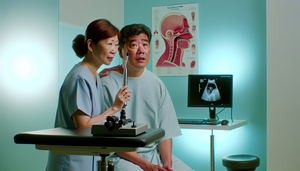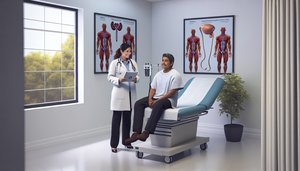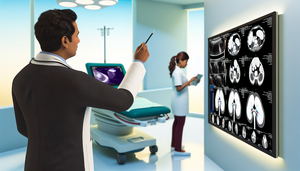
Meningioma: Morning Headaches, Personality Changes, and the Role of Neuroimaging in Early Detection
Early detection of meningiomas through neuroimaging enhances clinical management despite nonspecific symptoms.
Read more
Early Neurological Symptoms of Glioblastoma: The Importance of MRI for Timely Diagnosis of Persistent Headaches and Epileptic Seizures
Magnetic resonance imaging is crucial for the early diagnosis of glioblastoma, enhancing prognosis.
Read more
Acute Lymphoblastic Leukemia: Pediatric Warning Signs, Recurrent Infections, and the Importance of Bone Marrow Biopsy
Early detection of acute lymphoblastic leukemia in children improves clinical outcomes through warning signs.
Read more
Chronic Myeloid Leukemia: Early Identification and the Role of Cytogenetics in Diagnosis, Chronic Fatigue, and Splenomegaly
Early identification of chronic myeloid leukemia through cytogenetics improves prognosis and treatment.
Read more
Acute Myeloid Leukemia: Identifying Non-Specific Symptoms and Confirming Diagnosis with Bone Marrow Aspirate
Discover how to recognize nonspecific symptoms of acute myeloid leukemia and confirm with bone marrow aspiration.
Read more
Early Identification of Non-Hodgkin Lymphoma: Lymphadenopathy, Fever of Unknown Origin, and the Role of PET Scans in Diagnosis
Early identification of lymphadenopathy and the use of PET scans enhance the diagnosis of non-Hodgkin lymphoma.
Read more
Hodgkin Lymphoma: Painless Lymphadenopathy and the Role of Lymph Node Biopsy in Diagnosis
Explore how lymph node biopsy is crucial for diagnosing Hodgkin lymphoma in the presence of painless lymphadenopathy.
Read more
Nasopharyngeal Cancer: Recognizing Early Signs, Nasal Obstruction, and the Importance of Timely Nasofibroscopy
Early detection of nasopharyngeal cancer through nasofibroscopy significantly improves prognosis and treatment outcomes.
Read more
Laryngeal Cancer: Recognizing Persistent Hoarseness and Confirming Diagnosis with Direct Laryngoscopy for Early Detection
Persistent hoarseness may be an early sign of laryngeal cancer, diagnosable through direct laryngoscopy.
Read more
Oral Cancer: Stomatological Examination of Oral Lesions and the Importance of Early Detection in Differential Diagnosis
Early detection of oral cancer enhances survival through innovative diagnostic technologies and biomarkers.
Read more
Vulvar Cancer: Recognizing Persistent Itching and the Importance of Vulvar Biopsy in HPV Evaluation
Early detection of vulvar cancer through biopsy improves clinical outcomes and quality of life.
Read more
Vaginal Cancer: Early Warning Signs, HPV Risk Factors, and the Importance of Colposcopy
Vaginal colposcopy is essential for the early detection of vaginal cancer and precancerous lesions.
Read more
Endometrial Cancer: Early Warning Signs of Abnormal Uterine Bleeding and Biopsy Techniques
Early detection of endometrial cancer improves prognosis through SUA evaluation and biopsies.
Read more
Cervical Cancer: The Crucial Role of Pap Smear and Colposcopy in Early Diagnosis and HPV Detection
Early detection of cervical cancer through Pap smears and colposcopy reduces mortality.
Read more
Ovarian Cancer: Recognizing Early Pelvic Pain Signs and the Importance of CA-125 for Timely Diagnosis
Discover how to recognize early signs of ovarian cancer and the role of CA-125 in diagnosis.
Read more
Testicular Cancer: Self-Examination and Tumor Markers (AFP, β-hCG) for Early Detection of Testicular Mass
Early detection of testicular cancer improves prognosis through self-examination, ultrasound, and tumor markers.
Read more
Urothelial Carcinoma: Early Diagnosis through Hematuria Detection and Imaging Studies
Early detection of urothelial carcinoma through hematuria and imaging studies improves prognosis.
Read more
Renal Cancer: Ultrasound and CT Findings for Timely Diagnosis of Renal Cell Carcinoma
Timely diagnosis of renal cancer is enhanced by ultrasound and tomography, distinguishing between benign and malignant lesions.
Read more
Bladder Cancer: Early Detection of Initial Hematuria and Diagnostic Techniques
Early detection of hematuria and urinary biomarkers enhances the diagnosis of bladder cancer.
Read more
Prostate Cancer: The Role of PSA Testing and Digital Rectal Exam in Early Diagnosis
Early detection of prostate cancer improves with the combination of PSA, digital rectal examination, and new technologies.
Read more